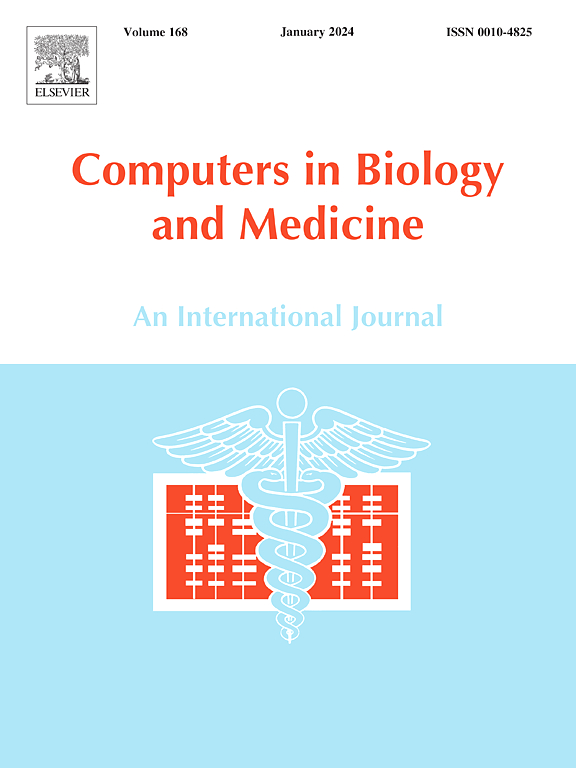使用智能手机IMU传感器进行心肺疾病检测的深度学习框架
IF 7
2区 医学
Q1 BIOLOGY
引用次数: 0
摘要
呼吸系统和心血管疾病是一个重大的全球健康负担,强调需要创新的、可获得的和具有成本效益的筛查解决方案。本研究介绍了一种临床基础框架,用于使用配备惯性测量单元传感器的商用智能手机进行心肺疾病的早期检测。所提出的方法利用在标准化协议下从五个不同胸腹区域收集的加速度计和陀螺仪数据,通过适合远程健康监测的非侵入性低成本技术获取呼吸运动学,特别是在资源有限的环境中或在大流行爆发期间。专门的预处理管道将时间序列分割成单个呼吸周期,然后使用双向循环神经网络对其进行分析,以在健康个体和心血管疾病患者之间进行二值分类。非健康队列包括术前诊断为瓣膜功能不全、冠状动脉疾病和主动脉瘤的患者。采用贝叶斯超参数优化留一交叉验证方法对模型进行训练和验证。实验结果显示了稳健的分类性能,平均灵敏度为0.81±0.02,特异性为0.82±0.05,F1评分为0.81±0.02,准确率为80.2%±3.9。在独立的未见健康个体集上,该模型的真阴性率为74.8%±4.5,证实了其泛化能力。拟议的框架为改善公共卫生、实现远程监测和支持临床医生进行早期诊断提供了一条有希望的途径。未来的工作应侧重于扩大数据集,完善长期监测的方法,并评估其在不同临床和家庭环境中的适用性。本文章由计算机程序翻译,如有差异,请以英文原文为准。
Deep learning framework for cardiorespiratory disease detection using smartphone IMU sensors
Respiratory and cardiovascular diseases represent a significant global health burden, underscoring the need for innovative, accessible, and cost-effective screening solutions. This study introduces a clinically grounded framework for the early detection of cardiorespiratory conditions using commodity smartphones equipped with inertial measurement unit sensors. The proposed method leverages accelerometer and gyroscope data collected under a standardized protocol from five distinct thoracoabdominal regions, enabling the acquisition of respiratory kinematics through non-invasive, low-cost technology suitable for remote health monitoring—particularly in resource-limited settings or during pandemic outbreaks. A dedicated preprocessing pipeline segments the time series into individual breathing cycles, which are then analyzed using a bidirectional recurrent neural network to perform binary classification between healthy individuals and patients with cardiovascular disease. The non-healthy cohort comprised preoperative patients diagnosed with conditions including valvular insufficiency, coronary artery disease, and aortic aneurysm. The model was trained and validated using leave-one-out cross-validation with Bayesian hyperparameter optimization. Experimental results demonstrated robust classification performance, with an average sensitivity of , specificity of , F1 score of , and accuracy of . On an independent set of unseen healthy individuals, the model achieved a true negative rate of , confirming its generalization capability. The proposed framework offers a promising avenue for improving public health, enabling remote monitoring, and supporting clinicians in early diagnosis. Future work should focus on expanding the dataset, refining the methodology for long-term monitoring, and assessing its applicability across diverse clinical and at-home settings.
求助全文
通过发布文献求助,成功后即可免费获取论文全文。
去求助
来源期刊

Computers in biology and medicine
工程技术-工程:生物医学
CiteScore
11.70
自引率
10.40%
发文量
1086
审稿时长
74 days
期刊介绍:
Computers in Biology and Medicine is an international forum for sharing groundbreaking advancements in the use of computers in bioscience and medicine. This journal serves as a medium for communicating essential research, instruction, ideas, and information regarding the rapidly evolving field of computer applications in these domains. By encouraging the exchange of knowledge, we aim to facilitate progress and innovation in the utilization of computers in biology and medicine.
 求助内容:
求助内容: 应助结果提醒方式:
应助结果提醒方式:


